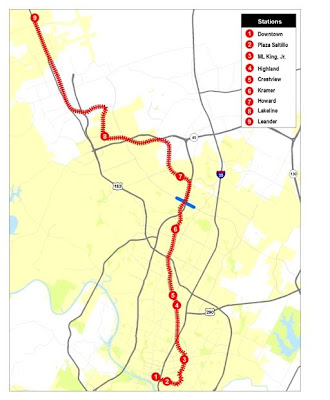Editorial from Saturday's Austin American-Statesman:
Capital Metro got it right this time. Earlier this week, the Capital Metro board approved a policy that would allow Cedar Park, Round Rock, Kyle, Elgin and other cities that are not participating in Capital Metro’s transit system a way to get in without using their sales taxes.
That was an important step because without that change, cities would not be able to buy full transit service from Capital Metro.
The new policy doesn’t mean that cities that opt into Capital Metro won’t pay for services. It just means that they don’t have to dedicate a penny of their sales taxes to Capital Metro, as Austin and Leander do. The sales tax requirement blocked cities from joining the Capital Metro family. Under the new policy, they can pay as they go.
Any arrangement for more cities to join the transit system, however, must not shortchange Austin and Leander residents. And that means that other cities must pay their fair share of costs for operations, maintenance, equipment and construction.
Austin Mayor Pro Tem Brewster McCracken, a member of the Capital Metro board, said financing arrangements would require new cities to cover all costs. He also assured us that service to Austin and Leander residents would not be reduced to accommodate new users that are currently outside the Capital Metro system. That is good.
Cedar Park voted itself out of the Capital Metro system in 1998 but now wants back in as commuter rail comes on line late this year or in January. Though a rail station will be built in Leander and the trains would run right through Cedar Park, they would not stop there — unless Cedar Park buys back into the system.
Round Rock, too, wants service. The city and Capital Metro officials are in talks about replacing Round Rock’s limited bus service with regular and expanded bus service by Capital Metro. Officials are discussing adding express service to certain destinations, such as the University of Texas and downtown.
Other cities that have expressed interest for Capital Metro services are Kyle, Dripping Springs and Elgin. That interest has been spurred largely by population growth of those cities. It is typical for residents to live one place, such as Round Rock, and work in Austin, and vice versa. One of the region’s largest employers, Dell Inc., has its headquarters in Round Rock.
Other factors, too, have contributed to the growing clamor for transit service in Central Texas, including traffic congestion (Austin has been repeatedly rated as the most congested mid-size city in the country), rising gas prices and concerns about air pollution.
Under the old way of doing business, Capital Metro was unable to expand transit service to other cities. The change allows Capital Metro to move toward creating a true regional transit system.
That is exactly what Central Texas needs.
Read more
 Read more
Read more
 Read more
Read more